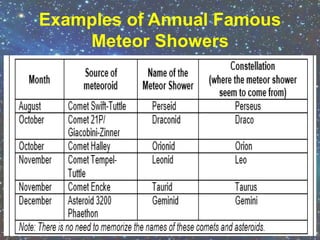Comets, asteroids, and meteors
- 1. COMETS,ASTEROID S AND METEORS Module 3 Enhanced Science Grade 8
- 3. CHARACTERISTICS COMET ASTEROID Origin Kuiper Belt and Oort Cloud Main Asteroid Belt Shape Varied/Irregular Varied/Irregular Size range of diameter (km) 1-10(nucleus only) 1-100++ Chemical Composition Ice (Frozen Water); Frozen gases (Ammonia, Methane, and Carbon dioxide); other organic compounds (Carbon- containing compounds) Silicates (Olivine and pyroxene), Iron, Nickel Orbit Highly Elliptical More Rounded Orbital period (years) 75 – 100,000++ 1-100
- 4. ORIGIN OF COMETS • Oort Cloud – is beyond Solar System. Long period comets All other comets that have identified are classified as a long- period comets.
- 5. Oort Cloud
- 6. ORIGIN OF COMETS • KUIPER BELT – is beyond Neptune’s orbit. Short period comets COMET HALLEY, the most famous comet of the 20th century is the only known short-period comet. It takes 75-79 years to orbit the Sun.
- 7. KUIPER BELT
- 8. ORIGIN OF ASTEROIDS Originate from the Main Asteroid Belt between Mars and Jupiter. • MAIN ASTEROID BELT - This belt is theorized by scientists to be remnants of a planet that did not completely form. ASTEROID 2012 DA14 made a very close approach to Earth as it orbited the sun. It was just 0.4 light year away from Earth. ASTEROID TOUTATIS also made a near approach to Earth but not close as Asteroid 2012 DA14.
- 10. CHEMICAL COMPOSITION OF COMETS • Ammonia, methane, and carbon dioxide. • Other organic compounds • Sometimes, it may contain other elements like Sodium or argon. COMET HALE-BOPP -contain argon which was believed to explain the very bright appearance of the comet in 1997.
- 11. COMET ANATOMY
- 12. IMPORTANCE: • The composition of a comet is important in helping scientists to understand how Earth has liquid water, which in turn made the planet liveable. • By studying comets’ orbits and the chemical composition of materials found in impact craters found all over Earth, soil and ice samples collected from drilling down Earth’s crust and marine layers.
- 13. CHEMICAL COMPOSITION OF ASTEROIDS • Mostly composed of rock (silicates) and metals (iron and nickel being the usual metals). • IMPORTANCE: -important in providing clues for scientists to discover more about the chemical composition of Earth and the other planets in the Solar system, as well as how life on Earth was affected by impacts in the past.
- 14. Near-433 Eros
- 15. Evidence • LUIS AND WALTER ALVAREZ The discovery of high contents of Iridium in Oceanic sedimentary layers in different parts of the world during the late 1970s led geologists proposed the Alvarez Hypothesis in 1980. ALVAREZ HYPOTHESIS -an asteroid with approximately 10 km in diameter made impact with Earth 65 million years ago. *They thought that the impact caused materials to be thrown up in air, thus blocking sunlight, and bringing about a period of winter long enough to cause a mass extinction of plants and animals, including dinosaurs.
- 17. • A meteoroidusually all burns up when it enters Earth’s atmosphere. • When a fragment from the meteoroid survives and makes it to the ground, this space rock fragment is now called a meteorite.
- 18. meteor moves swiftly and seems to fall on the ground. It “shoots” from a point in the sky, making people think that it is a shooting or falling star. METEOR SHOWER is named after the constellation where they seem to originate from, but this does not mean that the meteoroids come from the associated constellation. Remember: a meteor and a meteor shower are light phenomena; they are not stars.
- 19. Examples of Annual Famous Meteor Showers
- 20. How much and how well you can see meteors in the sky depend on several factors: 1. Air pollution; light pollution; 2. the time of day; 3. weather conditions; 4. size of the meteoroids; 5. source of the meteoroid (comet versus asteroid); 6. The number of meteors that can be seen during a meteor shower vary. *It starts with the appearance of a few meteors per hour, increasing in frequency until it reaches its peak of 1-2 meteors per minute, and then declines.
- 21. IMPORTANCE • Meteorites are of importance to scientists in studying the occurrence of different elements and compounds on Earth. • This information is in turn important in studying our mineral resources which is an important industry in any country.
- 22. three types of Meteorites
- 23. In the Philippines, there are only five meteorites that have been accepted internationally.
Editor's Notes
- They are remnants from the formation of our solar system 4.6 billion years ago.
- Scientists also discovered a faint sodium tail, a 3rd type of comet tail to add to the well-known dust and plasma (or ion) tails.
- Scientists theorized that the EARLY impact of comets on Earth brought liquid water to the planet.
- It’s the scientists’ belief that Earth, other planets, and asteroids are essentially similar in composition. In fact, ASTEROIDS are also called minor planets or planetoids.























